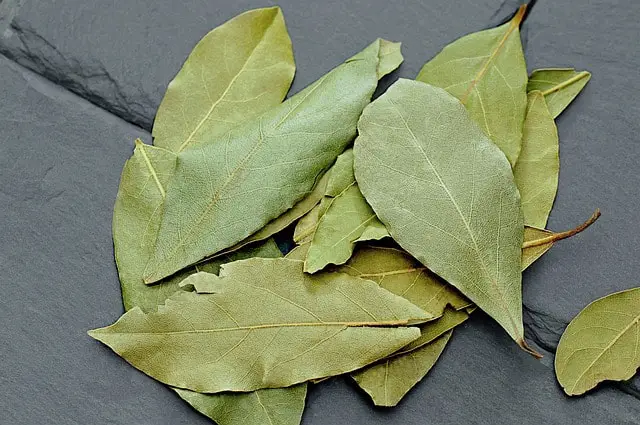Bay leaves are a very easy to use addition to cooking to add some flavor and aroma. Adding them to a dish literally involves just popping one or more leaves into the food while it’s being prepared.
Bay leaves are often used to flavor soups, stews, and sauces. They have a slightly bitter taste and a strong aroma that can add depth to a dish. Bay leaves are particularly popular in Mediterranean and Indian cuisine.
Soups, stews, sauces, rice and marinades benefit from bay leaves
Here are some ways to use bay leaves in your cooking:
- Add bay leaves to soups and stews: Bay leaves are a classic ingredient in many soups and stews. They add a depth of flavor and aroma that complements the other ingredients. Simply add a few bay leaves to your pot and let them simmer with the other ingredients.
- Use bay leaves in tomato sauce: Bay leaves are a great addition to tomato sauce. They add a subtle earthy flavor that complements the sweetness of the tomatoes. Add a couple of bay leaves to your tomato sauce while it simmers to infuse the flavor.
- Use bay leaves in rice dishes: Bay leaves can add a unique flavor to rice dishes. Simply add a couple of bay leaves to your rice while it cooks. This will add a subtle aroma and flavor to your dish.
- Add bay leaves to marinades: Bay leaves can add a depth of flavor to marinades. Simply crush a couple of bay leaves and add them to your marinade. Let the meat marinate for a few hours or overnight to infuse the flavor.
Sourcing and using bay leaves in your dishes
To use bay leaves in a dish, follow these simple steps:
- Choose high-quality bay leaves that are fragrant and free of blemishes. NOTE: Laurel is another name for bay leaves in case you come across it.
- Before using, rinse the leaves with cold water and pat dry with a paper towel. More on that below.
- Add the bay leaves to the dish early on in the cooking process, usually during the preparation of the base (such as onions, garlic, and carrots) or when you add liquid to the recipe.
- Only use a few bay leaves, as they are potent and can overpower the other flavors in the dish.
- Remember to remove the bay leaves before serving the dish, as they are not meant to be eaten and can be a choking hazard.
By following these steps, you can add a depth of flavor to your dish with bay leaves without much work on your part.
Why you wet bay leaves before use
Wetting bay leaves with water before using them can help to release their flavor and aroma. This is because the moisture helps to activate the volatile oils within the bay leaves that contain the essential oils responsible for their distinctive flavor and fragrance.
Additionally, wetting bay leaves can help prevent them from burning when added to hot oil or when toasted in a dry skillet. Burning bay leaves can release a bitter taste and spoil the flavor of your dish.
To wet bay leaves, you can simply rinse them under cold water or soak them in water for a few minutes before using. Then, pat them dry with a paper towel before adding them to your recipe. This step is not always necessary, but it can help to enhance the flavor of your dish.
Final thoughts
Bay leaves have a subtle, earthy flavor that can add depth to many dishes. They have a slightly bitter taste with a hint of sweetness and a floral aroma. When used in cooking, bay leaves are often used to infuse flavor into dishes like stews, soups, and sauces. The longer the bay leaves are cooked with the other ingredients, the more flavor they will impart.
Bay leaves can also be used to balance the flavors of a dish, particularly when used with rich, heavy ingredients like meats or beans. Overall, bay leaves add a unique and delicious flavor to many different dishes.
You might also be interested to learn about Bay leaf powder and how it compares to Bay leaves. Check out my article called What Is the Difference Between Bay Leaves and Bay Leaf Powder to learn more.
Ans if you’re wondering why bay leaves tend to be on the more expensive side, check out this article.

